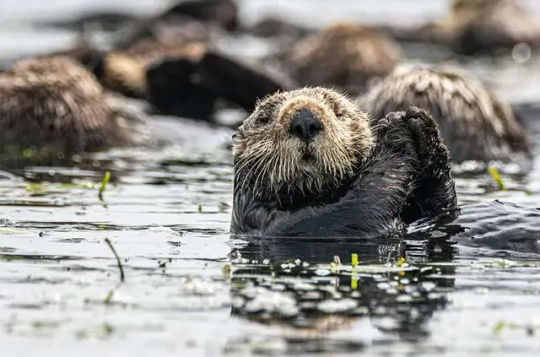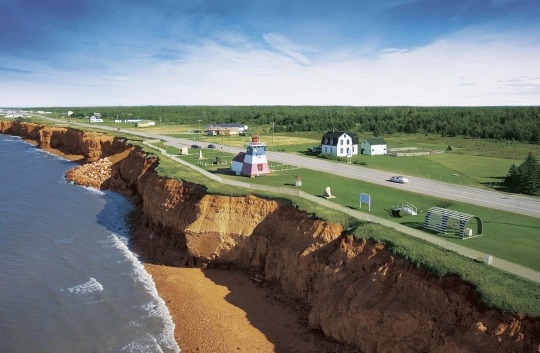#coastal erosion
Explore tagged Tumblr posts
Text
"Many people know about the Yellowstone wolf miracle. After wolves were reintroduced to the national park in the mid-1990s, streamside bushes that had been grazed to stubble by out-of-control elk populations started bouncing back. Streambank erosion decreased. Creatures such as songbirds that favor greenery along creeks returned. Nearby aspens flourished.
While there is debate about how much of this stemmed from the wolves shrinking the elk population and how much was a subtle shift in elk behavior, the overall change was dramatic. People were captivated by the idea that a single charismatic predator’s return could ripple through an entire ecosystem. The result was trumpeted in publications such as National Geographic.
But have you heard about the sea otters and the salt marshes? Probably not.
It turns out these sleek coastal mammals, hunted nearly to extinction for their plush pelts, can play a wolf-like role in rapidly disappearing salt marshes, according to new research. The findings highlight the transformative power of a top predator, and the potential ecosystem benefits from their return.
“It begs the question: In how many other ecosystems worldwide could the reintroduction of a former top predator yield similar benefits?” said Brian Silliman, a Duke University ecologist involved in the research.
The work focused on Elk Slough, a tidal estuary at the edge of California’s Monterey Bay. The salt marsh lining the slough’s banks has been shrinking for decades. Between 1956 and 2003, the area lost 50% of its salt marshes.
Such tidal marshes are critical to keeping shorelines from eroding into the sea, and they are in decline around the world. The damage is often blamed on a combination of human’s altering coastal water flows, rising seas and nutrient pollution that weakens the roots of marsh plants.
But in Elk Slough, a return of sea otters hinted that their earlier disappearance might have been a factor as well. As many as 300,000 sea otters once swam in the coastal waters of western North America, from Baja California north to the Aleutian Islands. But a fur trade begun by Europeans in the 1700s nearly wiped out the animals, reducing their numbers to just a few thousand by the early 1900s. Southern sea otters, which lived on the California coast, were thought to be extinct until a handful were found in the early 1900s.
In the late 1900s, conservation organizations and government agencies embarked on an effort to revive the southern sea otters, which remain protected under the Endangered Species Act. In Monterey Bay, the Monterey Bay Aquarium selected Elk Slough as a prime place to release orphaned young sea otters taken in by the aquarium.
As the otter numbers grew, the dynamics within the salt marsh changed. Between 2008 and 2018, erosion of tidal creeks in the estuary fell by around 70% as otter numbers recovered from just 11 animals to nearly 120 following a population crash tied to an intense El Niño climate cycle.
While suggestive, those results are hardly bulletproof evidence of a link between otters and erosion. Nor does it explain how that might work.
To get a more detailed picture, the researchers visited 5 small tidal creeks feeding into the main slough. At each one, they enclosed some of the marsh with fencing to keep out otters, while other spots were left open. Over three years, they monitored the diverging fates of the different patches.
The results showed that otter presence made a dramatic difference in the condition of the marsh. They also helped illuminate why this was happening. It comes down to the otters’ appetite for small burrowing crabs that live in the marsh.

Adult otters need to eat around 25% of their body weight every day to endure the cold Pacific Ocean waters, the equivalent of 20 to 25 pounds. And crabs are one of their favorite meals. After three years, crab densities were 68% higher in fenced areas beyond the reach of otters. The number of crab burrows was also higher. At the same time, marsh grasses inside the fences fared worse, with 48% less mass of leaves and stems and 15% less root mass, a critical feature for capturing sediment that could otherwise wash away, the scientists reported in late January in Nature.
The results point to the crabs as a culprit in the decline of the marshes, as they excavate their holes and feed on the plant roots. It also shows the returning otters’ potential as a marsh savior, even in the face of rising sea levels and continued pollution. In tidal creeks with high numbers of otters, creek erosion was just 5 centimeters per year, 69% lower than in creeks with fewer otters and a far cry from earlier erosion of as much as 30 centimeters per year.
“The return of the sea otters didn’t reverse the losses, but it did slow them to a point that these systems could restabilize despite all the other pressures they are subject to,” said Brent Hughes, a biology professor at Sonoma State University and former postdoctoral researcher in Silliman’s Duke lab.
The findings raise the question of whether other coastal ecosystems might benefit from a return of top predators. The scientists note that a number of these places were once filled with such toothy creatures as bears, crocodiles, sharks, wolves, lions and dolphins. Sea otters are still largely absent along much of the West Coast.
As people wrestle to hold back the seas and revive their ailing coasts, a predator revival could offer relatively cheap and effective assistance. “It would cost millions of dollars for humans to rebuild these creek banks and restore these marshes,” Silliman said of Elk Slough. “The sea otters are stabilizing them for free in exchange for an all-you-can-eat crab feast.”"
-via Anthropocene Magazine, February 7, 2024
#otters#sea otters#conservation#erosion#coastal erosion#coastline#marshes#saltwater#marine science#marine biology#marine animals#sea creatures#ocean#sustainability#soil erosion#erosion control#crab#good news#hope
3K notes
·
View notes
Text


#girl blogging#girl blogger#editorial#coastal erosion#coquette#it girl#dollette#hyper feminine#pinterest#chic
7 notes
·
View notes
Text

Acadian Coastal Drive, New Brunswick, Canada (source)
#don’t forget about Canada’s other French-speaking province!#canada#new brunswick#ocean#landscape#cliffs#coastal erosion#coastal landform#geography#geology#geomorphology#beach#lighthouse#atlantic ocean
11 notes
·
View notes
Text

“The Edge” by Zishaan A Latif.
Bengali-speaking Hindus and Muslims help each other shift shops from the edge of the Brahmaputra river at the Tarabari ferry point.
The shifting is done in anticipation of the erosion of land that occurs with each monsoon season, which is often devastating for residents as they are forced to constantly adapt to a changing landmass each year.
Tarabari, Bahari constituency, Barpeta district, Lower Assam, India, June 15, 2023.
Courtesy of World Press Photos
#human rights#art#humanity#equal rights#photography#bengali#tarabari#zishaan A Latif#erosion#coastal erosion#climate change#climate catastrophe#climate emergency#climate action#india#barpeta district#world press photo
5 notes
·
View notes
Text
Excerpt from this New York Times Op-Ed:
Last December a surprise storm passed through Florida’s Pinellas County, ripping away beaches and wiping out half of the sand dunes from St. Petersburg to Clearwater. The damage was extensive, and all the more painful because the county had just spent about $26 million hauling in sand to build up the dunes after a hurricane had pummeled them in August.
But this turn of events is far from unusual. Beach communities around the world are spending staggering sums replacing sand as big storms and rising seas wash it away. What used to be a maintenance task every 10 years or so is now often an annual event.
For many communities, engineering the beach is worth the hefty price tag to protect properties and tourism. But as climate change hastens beach erosion, trucking or shipping huge quantities of sand to replenish beaches is likely to become economically untenable and logistically impractical. Policymakers may soon have to make painful decisions about which shores and structures to save.
This doesn’t necessarily spell disaster for beach lovers. Beaches were intended to move around, and they’re better off when they do. Unlike other effects of climate change that look bleaker the further into the future you look, migrating beaches could ultimately make America’s coasts healthier by providing coral reefs and wildlife affected by sand replenishment with the habitats they need to thrive.
Beaches will only require more nourishment as worsening storms wash them away, sea level rise makes it harder to keep sand in place, excessive groundwater extraction causes land to sink and the rivers that once deposited sand on the coast dry up. Already beaches near San Diego and San Clemente, Calif., are shrinking by an average of 4.75 feet per year. Without them, nothing separates the fury of the ocean from the homes, resorts and other buildings that dot the shore.
Even finding sand has grown more difficult; many offshore reserves are already depleted, forcing dredging vessels to venture further offshore to find sand and dig it up from the ocean floor. In some places sand has to be transported by the truckload from inland at considerable extra cost — or even purchased from other countries.
4 notes
·
View notes
Text
Ugh. If only archaeology was being done in Libya... It's definitely a place with a huge number of sites, very few of which have been excavated.
11 notes
·
View notes
Text
Watch: Pacifica Coastal Erosion Jan 14 2024
youtube
#it's very expensive to live in Pacifica#king tides#january#2024#coastal erosion#climate change#youtube#drone
2 notes
·
View notes
Text
Why are we not doing what Japan is doing?
And, additionally: WHY are we not doing what Japan is doing (pt 2)?

I rolled up like a billion of these fuckers in Katamari, King of All Cosmos says get concreting morons
absolutely losing my mind that a bunch of nimby assholes spent $500k to build a sandcastle that was promptly wiped away
#actual important shit#grift#hustle#erosion#climate change#coastal erosion#katamari damacy#breakwater blocks#breakwater#know what the wise man built his house on?#A FUCKING ROCK#Jesus swearing#you know he WANTED to c'mon
63K notes
·
View notes
Text


Beneath the Shelter
This house, perched above the jagged rocks of Malibu's shore, serves as a reflection of the delicate balance that must be maintained between human ambition and the unyielding forces of nature. The second image zooms in on of the graffiti beneath its foundations, reflecting Nadav Kander's look into deterioration and the intersection of human presence and the environment. The landscape, set against the gloom of an overcast day, speaks to ideas of impermanence and the eerie beauty.
0 notes
Text
Geo Bags in Coastal Engineering: Managing Beach Erosion and Shoreline Protection

Coastal erosion poses a significant threat to shorelines worldwide, impacting ecosystems, infrastructure, and communities. In the realm of coastal engineering, geo bags have emerged as a versatile and effective solution for managing beach erosion and protecting shorelines. Singhal Industries Pvt Ltd, a leading packaging company stands out as a trusted Geo bags manufacturers in India, offering innovative solutions to address coastal challenges. This article explores the role of geo bags in coastal engineering, their benefits, and frequently asked questions about Singhal Industries' geo bag offerings.
Understanding Geo Bags in Coastal Engineering
Geo bags, also known as geotextile sandbags or geobags, are large, durable bags filled with sand, soil, or aggregate materials. They are typically made from high-strength geotextile fabric, designed to withstand harsh coastal environments and provide erosion control and shoreline protection. In coastal engineering, geo bags serve multiple purposes:
.Beach Erosion Control: Geo bags are used to stabilize shorelines and prevent erosion by absorbing wave energy and reducing sediment transport. They act as barriers, slowing down the movement of sand and sediment along the coast, thereby preserving beaches and coastal habitats.
.Shoreline Protection: Along with erosion control, geo bags provide protection against storm surges, tidal forces, and wave action. Placed strategically along vulnerable coastal areas, geo bags act as breakwaters or revetments, dissipating wave energy and minimizing damage to infrastructure and property.
.Infrastructure Support: Geo bags are utilized in the construction of coastal structures such as seawalls, groynes, and revetments. They provide a cost-effective alternative to traditional hard structures, offering flexibility, ease of installation, and minimal environmental impact.
Benefits of Geo Bags in Coastal Engineering
The use of geo bags in coastal engineering offers numerous advantages:.
.Flexibility: Geo bags can be easily transported and installed in remote or inaccessible coastal areas, making them suitable for a wide range of shoreline conditions and project requirements.
.Cost-Effectiveness: Compared to traditional hard structures like concrete seawalls, Geo bags price are more cost-effective to manufacture, transport, and install. They also require minimal maintenance over their lifespan.
.Environmental Sustainability: Geo bags minimize environmental disruption during installation and can be filled with locally sourced materials, reducing carbon emissions associated with transportation. They also provide habitat enhancement opportunities for coastal flora and fauna.
.Adaptability: Geo bags can be customized in size, shape, and filling material to suit specific project needs. This adaptability allows engineers to design tailored solutions for different coastal environments and erosion scenarios.
Singhal Industries' Geo Bags: Quality and Innovation
Singhal Industries Pvt Ltd stands at the forefront of Geo bag manufacturing in India, offering high-quality products and innovative solutions for coastal engineering projects. Here's why Singhal Industries is a preferred choice for geo bags:
.State-of-the-Art Facilities: Singhal Industries boasts state-of-the-art manufacturing facilities equipped with advanced machinery and technology for producing geo bags of superior quality and consistency.
.Customization Options: Singhal Industries offers customization options for geo bags, including size, strength, and filling material, to meet the specific requirements of coastal engineering projects.
.Competitive Pricing: Singhal Industries provides competitive pricing for geo bags, ensuring cost-effective solutions without compromising on quality or performance.
.Quality Assurance: Stringent quality control measures are implemented throughout the manufacturing process to ensure that Singhal Industries' geo bags meet international standards for durability, strength, and environmental sustainability.
In conclusion, geo bags play a crucial role in coastal engineering, offering effective solutions for beach erosion control and shoreline protection. Singhal Industries Pvt Ltd, with its commitment to quality, innovation, and environmental sustainability, remains a trusted manufacturer of geo bags in India, contributing to the resilience and preservation of coastal ecosystems and communities.
Frequently Asked Questions
Q: What are the advantages of using geo bags over traditional hard structures for coastal protection?
A: Geo bags offer several advantages, including flexibility, cost-effectiveness, minimal environmental impact, and adaptability to diverse coastal environments. Singhal Industries' geo bags provide effective erosion control and shoreline protection while offering greater design flexibility and sustainability.
Q: How are geo bags installed in coastal engineering projects?
A: Geo bags are typically filled with sand or aggregate materials on-site and then placed strategically along the shoreline or in the construction of coastal structures. Singhal Industries provides guidance and support for the installation of geo bags, ensuring proper placement and optimal performance.
Q: What factors influence the price of geo bags?
A: The price of geo bags depends on various factors, including size, strength, customization options, and order quantity. Singhal Industries offers competitive pricing for geo bags and provides transparent pricing information to clients.
0 notes
Text
https://hakaimagazine.com/videos-visuals/the-water-is-eating-the-island/
0 notes
Link
0 notes
Text

Tetrapod (structure)
“Tetrapods on Graciosa Island, Azores” - via Wikimedia Commons
#tetrapod#concrete#Wave-dissipating concrete block#breakwater#breakwater element#wikipedia#wikipedia pictures#wikimedia commons#engineering#erosion prevention#erosion#shoreline erosion#coastal#coastal shoreline#shoreline#photography
39 notes
·
View notes
Text

oh tennyson we're really in it now
#^ from the poem “in memoriam a.h.h.” except i screenshotted these lines out of a book abt geology & coastal erosion#thoughts#cliff blogging
72 notes
·
View notes
Text
i NEED a girl who wants to info dump about geography, history and/or architecture
#dream date she takes me to walk around sone medieval castle ruins and tells me about everything right down to the stones#dream date she takes me on a coastal walk and explains coastal erosion to me#dream date she takes me tober favourite historical place and tells me about everything that happened in incredible detail#its genuinely so attractive#bue waffling
29 notes
·
View notes